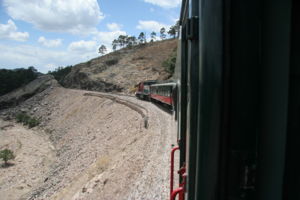Chihuahua al Pacífico
The Chihuahua al Pacífico Railroad, known as ChP or Chepe, is a major rail line in northwest Mexico, linking the city of Chihuahua, Chihuahua, to the town of Los Mochis, Sinaloa, near the Pacific coast. It runs 650 km (400 miles), traversing the Copper Canyon, a beautiful and rugged series of canyons that have led some to call this the most scenic railroad trip on the continent. It is both an important transportation system for locals and a draw for tourists.
The tracks pass over 37 bridges and through 86 tunnels, rising as high as 2,400 meters above sea level near Divisadero, a popular lookout spot over the canyons. Each one-way trip takes roughly 16 hours.
Contents
History
The idea for the railroad was officially started in 1880, when the president of Mexico, General Manuel González, granted a rail concession to Albert Kinsey Owen of the Utopia Socialist Colony of New Harmony, Indiana, USA, who was seeking to develop a socialist colony. Financial difficulties, spurred by the cost of building a railroad through the rugged canyons, plagued the project, and it was not until 1961 that the ChP was completed.
In 1998, the private rail franchise Ferromex took over the railroad from the Mexican government, which had operated all railroads since 1940.
Schedule
In general, two passenger trains run daily: one a slightly slower service with more stops for locals - 15 official stops and more than 50 "flagged stations" where stops can be made at passenger request - and the other a direct service for tourists that is faster and more expensive.
On its way from Los Mochis to Chihuahua it runs through El Fuerte, Temoris, Bahuichivo, Posada Barrancas, Divisadero, Creel among others.

